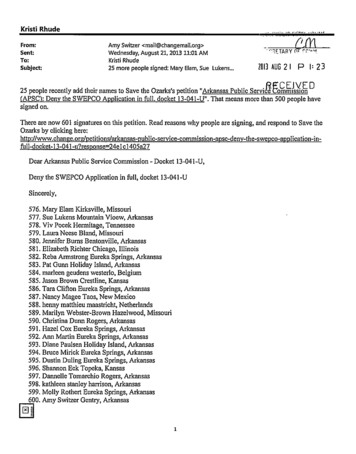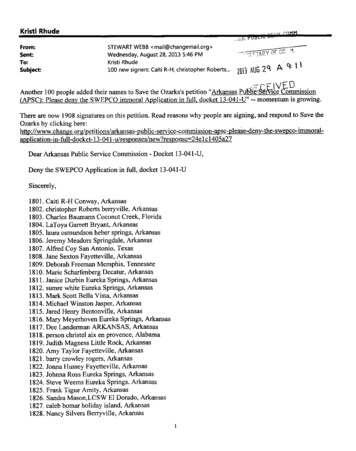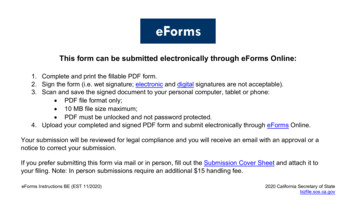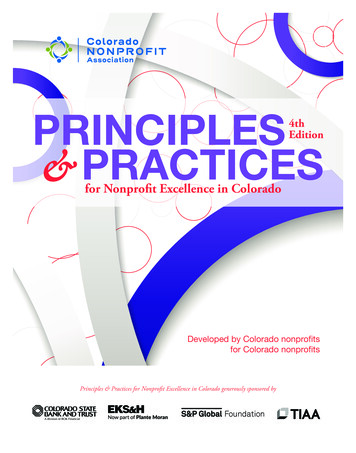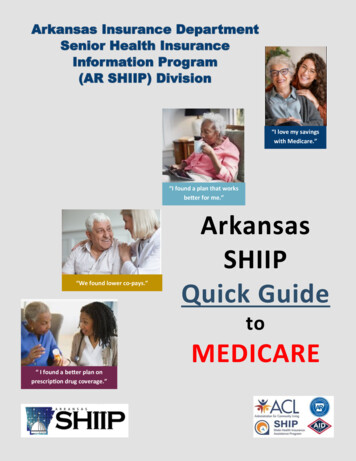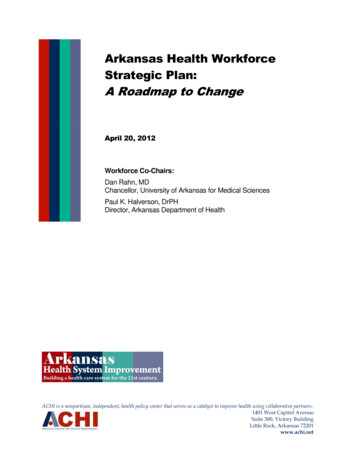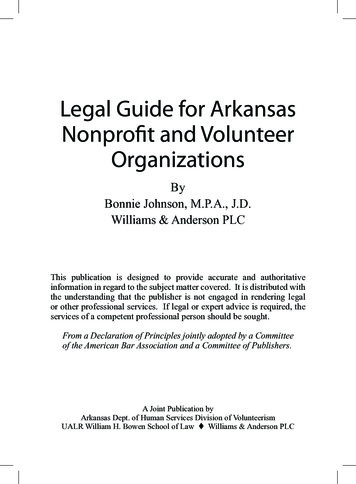
Transcription
Legal Guide for ArkansasNonprofit and VolunteerOrganizationsByBonnie Johnson, M.P.A., J.D.Williams & Anderson PLCThis publication is designed to provide accurate and authoritativeinformation in regard to the subject matter covered. It is distributed withthe understanding that the publisher is not engaged in rendering legalor other professional services. If legal or expert advice is required, theservices of a competent professional person should be sought.From a Declaration of Principles jointly adopted by a Committeeof the American Bar Association and a Committee of Publishers.A Joint Publication byArkansas Dept. of Human Services Division of VolunteerismUALR William H. Bowen School of Law t Williams & Anderson PLC
IntroductionGlance at the news, whether you prefer to read it electronically or in print,and you soon realize that we are once again becoming a nation of serviceminded individuals. Arkansans are ahead of this curve and in a positionto demonstrate leadership in this era of renewed interest in service andin the non-profit sector. This book was written as a guide to help thoseindividuals achieve their goals and see their projects come to fruition.As Dean of the Bowen School of Law and as an inaugural faculty memberof the University of Arkansas Clinton School for Public Service, I havea unique perspective on how people become interested in public serviceand volunteerism. Law degrees are often associated with high-poweredindividuals working in tall buildings and commanding large salaries.While some do use their education to pursue that type of career, manymore end up pursuing service related careers, especially in the non-profitsector. The mission statement of the Bowen School of Law states that oneof our five main objectives is “To serve public interest through a widerange of public service activities for the State of Arkansas ” By exposingour students to volunteerism during law school, Bowen Law School isfulfilling its mission and is itself providing a service to the community.The “service connection” with the UA Clinton School for PublicService is much more apparent (the name of the school gives it away).The concurrent JD/MPS degree, a one-of-a-kind program, producesindividuals who not only use their education to serve local communitiesbut also the global community. Think of it – these students who havea connection to Arkansas are affecting change through service worldwide. That is exciting stuff.I hope this guide is used often; by those whom I have had the privilegeto teach and by those I’ll never meet. I hope all of you experience the joyof seeing your ideas come to life, the reward of seeing your projects helpthose in need, and the satisfaction of serving instead of being served.John M. A. DiPippaDean and Distinguished Professor of Law and Public Policy,UALR William H. Bowen School of Lawiii
AcknowledgementsThis manual was made possible by a partnership between theDepartment of Human Services Division of Volunteerism, Williams &Anderson PLC and the UALR William H. Bowen School of Law. Wewould like to thank the following individuals for the time and talent theyinvested in this project.Division of VolunteerismDeLora ButlerSelena EllisEdet FrankSherry MiddletonApril NullAlbert SchneiderWilliams & Anderson PLCAssociatesDaniel BeckKelly DeGostinBonnie JohnsonAndrew KingStudent Law ClerksAaron BrooksMatthew J. FoersterLindsey C. PesekUALR William H. Bowen School of LawDean John DiPippaProfessor Jessie Wallace Burchfield
About the AuthorBonnie Johnson is an attorney with Williams & Anderson PLC inLittle Rock, Arkansas, practicing in the areas of litigation, appellate,employment and nonprofit law. Before joining the Arkansas Bar, Ms.Johnson worked for twenty-five years with nonprofit organizations inArkansas. Her most recent position was executive director of NonprofitResources, an organization dedicated to developing the capacity andinfrastructure of Arkansas’s nonprofit sector. Ms. Johnson remainsactive in nonprofit work. She serves on the Arkansas Governor’sCouncil on Developmental Disabilities and the board of directors of theDisability Rights Center, Arkansas’s protection and advocacy system forpeople with disabilities. She founded the Jennifer L. Carson scholarshipendowment, which is managed by the Arkansas Community Foundationand provides a scholarship each year for a student at the William H.Bowen School of Law who is a single parent.vi
Table of ContentsChapter 1Chapter 2Chapter 3Chapter 4Chapter 5Chapter 6Appendix AAppendix BAppendix CAppendix DThe Birth of a Nonprofit.1The Nonprofit Board of Directors.23Theories of Liability and the NonprofitBoard Member.45Volunteers.61Personnel Issues inVolunteer Management.75Risk Management.101Selected Resources.121IRS Sample Conflict of Interest Policy.127Outline of Subjects Typically Coveredin Bylaws.135Arkansas Statutes of Special Interestto Nonprofits.137The Arkansas Nonprofit CorporationAct of 1963.137The Arkansas Nonprofit CorporationAct of 1993.138Act 569 of 2007.140Statutes Regulating Solicitation ofContributions and Registration ofFundraisers.140The State and Local GovernmentVolunteers Act.147The Arkansas Civil RightsAct of 1993.148The Fair Labor Standards Act andArkansas Wage and Hour Law.148vii
CHAPTER IThe Birth of a NonprofitBig News in Little DipperObesity and poor nutrition are major problems amongchildren in communities across America. Claire Morgan’shometown of Little Dipper, Arkansas, is no exception. In fact,the Arkansas Department of Education had just published astudy listing the children of Little Dipper Elementary Schoolas among the heaviest in the state.The report was front-page news in the Little Dipper Gazetteand caused a tremendous stir among Little Dipperans. MayorJanet Hightower called an emergency town-hall meeting.Because Claire is Mayor Hightower’s personal trainer anda local physical fitness guru, the Mayor asked her to attend.Everyone at the meeting agreed that a comprehensivecommunity initiative was needed. They even came up witha clever name for the program: K-Child, which stands for“Keeping Children Healthy In Little Dipper.”It seemed like the whole town had promised its support.Local car dealer “Big Bill” Robbins was so inspired that heimmediately wrote a check for 10,000 and pledged his fleetof minivans to the program. Reverend Marcus Bailey said theprogram could use a spare office in his church’s gymnasium.Principal Cynthia Roosevelt promised her cooperation andsupport in working with the children at the elementary school.Several people signed a mailing list to volunteer their skillsand time to the effort. Claire volunteered to organize theentire initiative.Legal Guide for Arkansas Nonprofit and Volunteer Organizations
When she got home from the meeting, Claire was excitedabout all of the good things she planned to do to help thechildren of Little Dipper lead healthier, more active lives. Atthe same time, she began to wonder if she had taken on toomuch responsibility. Questions and doubts started to fill hermind: Did she need to have a meeting? Who was responsiblefor making sure everything worked out? What was she goingto do with the check for 10,000? What if someone got hurtat an activity? Did she need insurance?IntroductionMost of us have been like Claire at some point in our lives,facing a new challenge and not sure what to do next. This canbe especially true when the law is involved—even a lawyermay need some time to figure out one’s rights, or the legalimplications of one’s actions and decisions. The purpose ofthis book is to explain many of the legal issues that commonlyface individuals in the field of volunteer program management.Recognizing that most of this book’s readers will not have formallegal training, the authors seek to describe legal issues from thepoint of view of volunteer managers, in terms of situations theycommonly face.Each chapter of this book begins by describing a situationconfronting the fictional Claire Morgan and her organization, KChild, in the imaginary town of Little Dipper, Arkansas. Fromthere, the authors discuss the legal issues that Claire may face, Chapter I — The Birth of a Nonprofit
and what steps she can take to ensure that the interests of herorganization, K-Child, are achieved. It is our hope that, afterreading this book, volunteer managers will be more comfortablewith relevant legal issues and will have a better idea of when it istime to contact an attorney.Returning to Claire, it seems like she is off to a great start.She has an office, volunteers, money, and community support.So, why is she still worried? It turns out that there are goodreasons for Claire’s concerns, and a few things she needs to dobefore K-Child begins full-scale operations.The Nature Of NonprofitsArkansas law recognizes three basic categories oforganizations: governments, for-profit businesses, andnonprofits. Each category has distinct legal structures and thedifferences are significant under the law. The most notablecharacteristic of a nonprofit organization is that it cannotdistribute its earnings to the individuals who control it.1 Unlikea for-profit entity, a nonprofit does not have private owners orshareholders who benefit personally from the activities of theorganization. In its definition of a corporation exempt fromtaxation, section 501(c)(3) of the Internal Revenue Code statesthat “no part of the net earnings . . . inures to the benefit of anyLegal Guide for Arkansas Nonprofit and Volunteer Organizations
private shareholder or individual.” This means that no part ofthe net earnings of the organization may be used to benefit aprivate shareholder or individual. A nonprofit may earn a profitand may even engage in commercial activities. (See discussionof unrelated business income tax, below.) For example, theGirl Scouts may sell cookies and the Red Cross may buy, sell,and hold real estate. Profits or earnings from these endeavorsmust be used in a way that furthers the nonprofit purpose of theorganization. Nonprofit status is conferred by the State, but tobe recognized as exempt from income tax, an organization mustapply to the Internal Revenue Service (the “IRS”).This manual is written primarily for the incorporatednonprofit charitable organization that qualifies for tax-exemptstatus under Internal Revenue Code section 501(c)(3). Likemost charitable groups that intend to solicit donations from thegeneral public, K-Child will probably choose to incorporate andapply for IRS recognition of its 501(c)(3) status. It is possible,however, to operate as a nonprofit under a less formal structure.Creating an Unincorporated Nonprofit AssociationUnder Arkansas law, K-Child could become an unincorporatednonprofit association without taking any formal steps. A groupof at least two people agreeing to act for a common, nonprofit Chapter I — The Birth of a Nonprofit
purpose is considered an unincorporated nonprofit association.2Although it has not filed any formal documents with the state,a nonprofit association is a legal “person,” that is, it can ownproperty and sue (or be sued) separate from its members.3 Thismeans that, if K-Child was a nonprofit association, Claire couldopen a checking account and enter into contracts in K-Child’sname instead of her own. Even better for someone like Claire, KChild’s status as a nonprofit association would limit some of herliability for the organization’s obligations.4A person is liable (or has liability) if she may be held legallyresponsible to another person or to society.5 Liability is animportant idea in the law. If there is a lawsuit and a jury findsthat a person is liable, the court can order that person to paymoney to another person. As long as Claire tells the people shedeals with that she is acting on behalf of K-Child, and not herselfindividually, she should not be liable for its debts.6While several people have volunteered to help K-Childachieve its goals, it is not clear that anyone other than Claire canbe considered a member of the organization.7 For this reason,it is a good idea for Claire to undertake some formal steps sothat everyone can be sure that K-Child is clearly a nonprofitassociation under Arkansas law. First, she should contact theother potential members and discuss the overall purpose of theLegal Guide for Arkansas Nonprofit and Volunteer Organizations
organization. Then, they should put their understanding in writing,stating the organization’s name, describing its purpose, listing itsmembers, and stating what property belongs to the association.This organizing document does not need to have any particularname, but it may be called the “Articles of Association,” or“Constitution.”8 It should be signed and dated by at least twomembers.9 Because Claire’s organization already has significantfunding and numerous volunteers, she may want to seek the helpof an attorney to help K-Child come up with a more detailedorganizing document. While state and Federal laws allow KChild to operate as an unincorporated nonprofit association, mostnonprofit associations choose to incorporate. The incorporationprocess is described below.Incorporating as a NonprofitAlthough K-Child could continue to operate as anunincorporated nonprofit association, it will probably decide tobecome a corporation, a more formal structure that adds stabilityand credibility to the organization. The primary advantage ofincorporation is that it limits the liability of board members andmanagers of the organization. Another benefit is that the law ofcorporations is better developed than the law of unincorporatednonprofit associations. Consequently, an incorporated nonprofit Chapter I — The Birth of a Nonprofit
has a clearer legal position and its directors, officers and membersare more likely to be insulated from liability. Foundations, forprofit corporations, and other donors may be unfamiliar withunincorporated nonprofit associations and, therefore, morecomfortable giving to organizations that have incorporated.Similarly, banks and other businesses may be disinclined to dealwith unincorporated groups. For these reasons, an organizationlike K-Child that intends to seek funding and expand its serviceswill usually incorporate.This is the point at which many groups like K-Child begin towonder whether they need the services of an attorney. While it iscertainly possible to establish a tax-exempt nonprofit corporationwithout legal assistance, an attorney who is knowledgeableabout nonprofit issues can be a big help. Incorporating as anonprofit is a fairly simple matter of drafting adequate articlesof incorporation and filing with the Arkansas Secretary of State.After incorporating, most nonprofits seek recognition of their taxexempt status from the IRS, a process that is considerably morecomplicated than incorporation. Legal representation, while notstrictly necessary, can ease the burden of dealing with the IRS andfree the group to attend to the many tasks inherent in getting a newnonprofit off to a good start.Legal Guide for Arkansas Nonprofit and Volunteer Organizations
Drafting and filing articles of incorporationTo incorporate as a nonprofit, K-Child will need to draftarticles of incorporation and file them with the ArkansasSecretary of State. Under Arkansas law, the articles ofincorporation must include:t the name of the organization;t the name and address of the corporation’sincorporators;t a statement as to whether the organization will havemembers (see discussion of membership below);t an explanation of how the organization’s assets willbe distributed if it shuts down; 10 andt the name and address of the corporation’s firstregistered agent.11The Articles may also include:t a statement of the organization’s purpose,t the names and addresses of the initial directors, andt provisions related to the management andgovernance of the organization.12 Chapter I — The Birth of a Nonprofit
The Articles must declare whether the organization is a publicbenefit, mutual benefit, or religious corporation.13 Usually anonprofit that intends to seek recognition of 501(c)(3) tax statuswill be either a public benefit or religious corporation. A mutualbenefit corporation is an organization such as a trade associationor chamber of commerce that exists primarily to advantage itsmembers. Since K-Child’s purpose is to serve the children ofLittle Dipper and it is not a religious organization, it will be apublic benefit corporation.The office of the Arkansas Secretary of State is a usefulresource for developing nonprofits. Its website, at www.sos.arkansas.gov, offers general information about nonprofitcorporations and accommodates on-line filing of articles ofincorporation. Articles of incorporation also may be filed at theSecretary of State’s office in the Arkansas State Capital building,room 256. The filing fee is 50.14Holding an organizational meetingOnce the articles of incorporation are filed, the incorporatorsor initial directors of the newly formed corporation should holdan organizational meeting.15 The purpose of this meeting is toelect officers, adopt bylaws and conduct any other necessarybusiness. The directors need to choose an “accounting year” andLegal Guide for Arkansas Nonprofit and Volunteer Organizations
authorize bank accounts and signatories, the filing of documentsnecessary to obtain tax-exempt status, and other actions necessaryto begin operations. An organization’s “accounting year” is theannual period that the organization uses for computing its incomeand keeping its books. Thus, the organization should choose anaccounting year that corresponds with its natural cycle of financialactivity. The organization can choose the normal calendar year,which would mean an accounting year that begins January 1 andends December 31, or it can choose another 12-month period thatends on the last day of any month other than December. If initialdirectors are not named in the articles of incorporation, then theincorporators should elect a board of directors, which will thenproceed to conduct the necessary business.Arkansas reporting requirementsA new law passed by the 2007 General Assembly requiresnonprofit organizations to make an annual disclosure to theSecretary of State.16 By August 1 of each year, K-Child must filea statement with the Arkansas Secretary of State that providesthe following information: The name of the corporation; The corporation’s place of incorporation; The name and address of the corporation’sregistered agent for service of process;10 Chapter I — The Birth of a Nonprofit
The address of the corporation’s principal office; The names of the corporation’s principalofficers; and The names and addresses of the corporation’sdirectors.17If K-Child fails to file this statement within sixty (60) daysafter it is due, the Secretary of State is authorized to commence aproceeding to dissolve the corporation.18Deciding Whether to Have MembersSome nonprofits choose to have members; others do not.The primary reason for members is to allow a large number ofpeople to be involved in the governance of the organization byelecting the board of directors and deciding other major issues.Members of a nonprofit organization may be compared toshareholders in a for-profit, but they do not hold stock and theydo not really own the organization. If anybody can be said to“own” a nonprofit, it is the public served by the organization.Members and directors represent the interests of that public.Membership can be a good way to build support for themission of the organization, but only if members are motivatedto stay informed and play a meaningful role. Recruitingmembers and keeping them informed and involved can be time-Legal Guide for Arkansas Nonprofit and Volunteer Organizations 11
consuming and expensive. A membership organization shouldhave a good plan for keeping up with members and ensuring thatthey are involved enough to take their role, including electionof the board of directors, seriously. The Arkansas NonprofitCorporation Act of 1993 requires a nonprofit corporation tomaintain a membership list, including an address for eachmember and the number of votes to which each member isentitled.19Some organizations have “members” who are actuallydonors or participants with no power to elect the board ofdirectors or otherwise participate in governance. For example,a nonprofit athletic club may charge “membership” dues to useits facilities, but not afford such members a vote. For the sake ofclarity, it is better to find a term other than “member” to describesuch persons. At a minimum, the organization should make itclear that these are non-voting memberships.In most nonprofits without members, the board of directorsis self-perpetuating, meaning that the board members themselveselect the board. For this system to work well, most boards willneed to make an ongoing effort to recruit new members andotherwise provide for a turnover of power.12 Chapter I — The Birth of a Nonprofit
Tax-Exempt StatusAs it now stands, K-Child may have to pay income taxes onmoney that the organization receives. In addition, anybody whomakes a gift to K-Child will not be able to deduct the donationfrom his or her federal or state income taxes. Of course, both ofthese issues could make it much harder for the organization toraise money, do its work, and achieve its goals. For these reasons,K-Child should seek IRS recognition of its tax-exempt statusimmediately.Attaining tax-exempt statusAn organization may be exempt from state and federaltaxation if it is organized and operated “exclusively forreligious, charitable, scientific, testing for public safety, literary,or educational purposes, or to foster national or internationalsports competition or for the prevention of cruelty to . . .animals.”20 These organizations are commonly called “501(c)(3)organizations” because of the section of the U.S. tax code wherethe exemption is found. Because it is organized for the purposeof educating children about good nutrition and physical activity,K-Child will probably qualify under section 501(c)(3). Bothunincorporated associations and incorporated nonprofits may seekrecognition of 501(c)(3) status from the IRS.Legal Guide for Arkansas Nonprofit and Volunteer Organizations 13
K-Child will apply for tax-exempt status by using IRS Form1023. Before K-Child may complete Form 1023, though, itmust obtain an Employer Identification Number (EIN) from theInternal Revenue Service.21 An Employer Identification Numberis an organization’s account number with the IRS, similar to anindividual’s Social Security Number. It is needed even if K-Childdoes not plan to have any employees.22 K-Child can apply for anEIN by calling 1-800-829-4933, submitting Form SS-4, or visitingthe IRS website at www.irs.gov.23At twenty-eight pages long, Form 1023 is rathercomplicated, seeking information regarding the nonprofit’sstructure, operations, finances, fundraising activities, andmembership.24 It also requires that an organization’s organizingdocument contain a “Purpose Clause” and a “DissolutionClause.”25 Many nonprofits seek an attorney to help themobtain tax-exempt status, often the same attorney who helpedto draft the organizing documents. Once the IRS issues a TaxDetermination Letter, the nonprofit may also apply for anexemption from Arkansas income taxes using Form AR1023CT,a form much shorter than the federal version.26Keeping tax-exempt statusAfter attaining tax-exempt status, K-Child will be subject14 Chapter I— The Birth of a Nonprofit
to certain federal requirements and restrictions with which itmust comply in order to maintain its tax-exempt status. Theserequirements and restrictions have similar objectives. Theyare designed to ensure that K-Child is conducting its affairs ina manner that furthers the purpose for which it was organized,educating children about good nutrition and physical activity.They are also designed to discourage K-Child from engagingin activities that cause K-Child to look more like a for-profitcompany than an organization with a charitable purpose.IRS Form 990; Annual notice required under the PensionProtection Act of 2006Each year most tax-exempt organizations must file a Form990. Form 990 is often called an “informational return,” as itrequires the organization to provide the IRS with informationabout its receipts, disbursements, expenses, and all otherinformation required under section 6033 of the Internal RevenueCode. Form 990 is not a typical tax return, in that it is not usedby the IRS to determine the amount of tax owed. Rather, it is amechanism by which the IRS is reassured that K-Child deservesto keep the tax-exempt status that it has been granted.The following tax-exempt organizations do not have tofile a Form 990: (1) “churches, their integrated auxiliaries,and conventions or associations of churches;” (2) certainLegal Guide for Arkansas Nonprofit and Volunteer Organizations 15
organizations that are not private foundations and whose yearlygross receipts normally do not exceed 5,000; and (3) “theexclusively religious activities of any religious order.”27 The IRSalso has the discretion to exempt other organizations from thisfiling requirement, and it has done so by increasing the 5,000yearly gross receipts limit to 25,000 for many tax-exemptorganizations that are not private foundations.28Even though there are several organizations that do nothave to file a Form 990, the Pension Protection Act of 2006 (the“PPA”) created new notification requirements for organizationswhose yearly gross receipts normally do not exceed 25,000.29Under section 1223 of the PPA these organizations must provide,in electronic form, the following information: (1) the legal nameof the organization; (2) any name under which the organizationoperates or does business; (3) the organization’s mailing addressand website address (if it has one); (4) the organization’staxpayer identification number; (5) the name and address of aprincipal officer; and (6) evidence of the continuing basis for theorganization’s exemption from the Form 990 filing requirementin section 6033 of the Internal Revenue Code.30The Act also describes the penalty for an organization’sfailure to file a Form 990 or failure to comply with the Act’snotification requirements. If an organization does not comply16 Chapter I — The Birth of a Nonprofit
with the Form 990 or notification requirement for threeconsecutive years, the organization’s tax-exempt status will berevoked.31 An organization whose status is revoked must reapply if it wants to have its tax-exempt status reinstated.32Section 4958 intermediate sanctionsAs mentioned above, Internal Revenue Code section501(c)(3) states that “no part of the net earnings of [a taxexempt organization may inure] to the benefit of any privateshareholder or individual.” This restriction is often referred toas the inurement limitation. The inurement limitation addressestransactions between an organization and “insiders,” such asfounders, directors, and officers. Inurement occurs when theinsider receives a disproportionate benefit as a result of his or hercontrol over the organization. Examples of a disproportionatebenefit are paying excessive compensation to one of K-Child’sofficers or making a below-market rate loan to one of K-Child’sboard members. Under the inurement limitation, if an insiderreceives a disproportionate benefit, the only sanction is a severeone, revocation of the organization’s tax-exempt status.Because of the severity of the sanction, the IRS historicallydid not enforce the inurement limitation very often. Therewas a concern that an organization would have to suffer aLegal Guide for Arkansas Nonprofit and Volunteer Organizations 17
disproportionately severe punishment for a small inurementviolation. Things changed in 1996 when section 4958 wasadded to the Internal Revenue Code. Section 4958 is knownas “intermediate sanctions” legislation because it creates amiddle ground between no sanction and the ultimate sanction(revocation of tax-exempt status) for violation of the inurementlimitation. Rather than revoking an organization’s tax-exemptstatus for engaging in an inurement transaction, section 4958imposes a lighter penalty, an excise tax. This excise tax isimposed on the individual who benefited from the transaction,and the tax is twenty-five percent (25%) of the amount of theexcess benefit that the individual received.33 A lesser excise taxpenalty may be imposed on any officer, director, or trustee of theorganization if she knowingly allowed the organization to engagein the transaction; however, she will not be subject to the penaltyif she can show that her involvement in the transaction was “notwillful and [was] due to reasonable cause.”34A significant aspect of the section 4958 intermediate sanctionsis that they apply to anyone considered a “disqualified person.”An individual with a formal title, such as chairman of the boardof directors, is a disqualified person. But, additionally, someonewithout a formal title, yet still in a position to exert substantialcontrol over the organization, is also treated as a disqualifiedperson.35 Furthermore, the family member of a disqualified person18 Chapter I — The Birth of a Nonprofit
is treated as a disqualified person for purposes of imposing thepenalty
this book is to explain many of the legal issues that commonly face individuals in the field of volunteer program management. Recognizing that most of this book's readers will not have formal legal training, the authors seek to describe legal issues from the point of view of volunteer managers, in terms of situations they commonly face.
